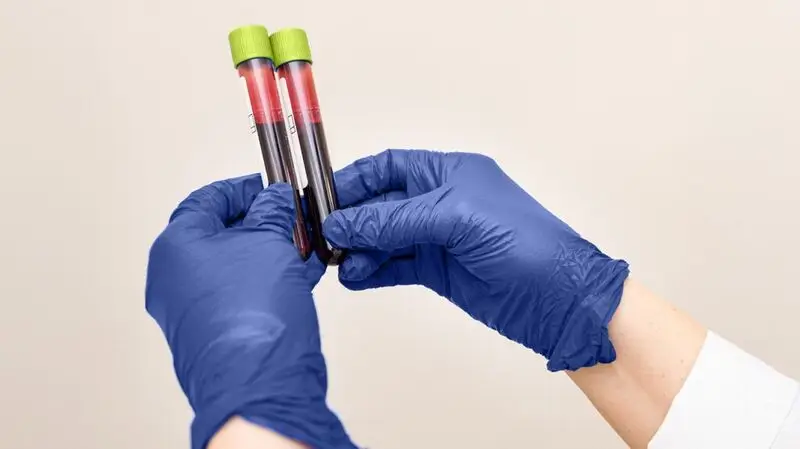
- Celiac disease has to do with an abnormal immune response of the body to gluten.
- Experts are interested in the best ways to test for celiac disease.
- A recent study discovered that a blood test called WBAIL-2 could aid in diagnosing celiac disease and even contribute to biopsy-free diagnosis.
A study recently published in Gastroenterology evaluated the effectiveness of using a blood test that measures the
The study’s results indicated that the test to be highly effective for celiac disease diagnosis, even for people following a gluten-free diet.
The test could offer another option to help with celiac disease diagnosis — importantly, one that would not require triggering symptoms to confirm the disease.
The authors of the current study note that there is often a delay or lack of diagnosis when it comes to celiac disease. Diagnosis usually involves people having to eat gluten and get biopsies of the small intestine.
Celiac disease also has to do with the response of a group of immune cells, CD4+ gluten-specific T-cells. For this study, researchers wanted to determine if the use of a blood test that measures interleukin-2 — a protein produced by some T-cells — release could help to accurately diagnose celiac disease.
This research involved a total of 181 adult participants between 18 and 75 years old. Of these participants, 88 had celiac disease, and others were controls. Among controls, 32 participants had a non-celiac gluten sensitivity and were on a gluten-free diet. The rest were healthy controls who did not have gluten sensitivity.
All participants provided blood samples, and researchers collected data on medications and medical history.
A subset of participants, including healthy controls, participants with non-celiac gluten sensitivity, and treated celiac disease, went on a gluten-free diet for four weeks or more and then consumed gluten for “a single-dose open-label gluten challenge.”
Some participants with treated celiac disease also did an oral gluten challenge that lasted 3 days. If participants underwent the oral gluten challenge, they used diaries to keep track of their symptoms.
Researchers utilized a blood test called a WBAIL-2 assay, which measures the release of interleukin-2 in vitro after adding gluten peptides.
In general, the test was able to effectively confirm celiac disease, with higher concentrations and fold change of interleukin-2 in participants who had celiac disease. However, the results were less sensitive for participants with a certain, less common genotype.
Analysis results also found that the WBAIL-2 assay correlated with age and the number of years participants had been following a gluten-free diet.
Next, researchers tested participants’ serum levels of interleukin-2 after they did an oral gluten challenge. The levels of interleukin-2 were higher for participants with celiac disease following the oral gluten challenge.
Researchers also found these levels “positively correlated with the WBAIL-2 results.” So, if the levels of interleukin-2 were elevated on one test, they were also elevated on the other.
They also tested how the WBAIL-2 results related to the presence of gluten-specific T cells, which were higher among participants with celiac disease. They did find that the presence of these cells, as well as activated versions of these cells, correlated with the WBAIL-2 test.
The researchers further found that gluten-specific T cells, activated versions of these cells, and WBAIL-2 increased after participants underwent a gluten challenge. However, one participant had lower gluten-specific CD4+ T cells and a lower WBAIL-2 test on day six.
Researchers also looked at treated celiac disease participants and how the tests related to their symptoms after gluten exposure. When it came to gluten-specific T-cells, their frequency was higher in participants who experienced vomiting. The measurement of serum interleukin-2 following the gluten tolerance test was also elevated, as was the WBAIL-2 level. The WBAIL-2 level was also increased greatly for one participant who did not experience vomiting but did report severe tiredness.
Further analysis also suggested that activated gluten-specific CD4+ T cells are the cells that lead to gluten-induced production of interleukin-2.
The results suggest that the WBAIL-2 assay can help with celiac disease diagnosis, even when people are already following a gluten-free diet.
There are some limitations to this study. For one thing, it was performed out of one area, most participants were female, and there were strict inclusion criteria, so it has a limited generalizability.
It also had small sample sizes for some subgroups, which means more research may be particularly necessary in these subgroups. Since researchers did not test children or people taking immunosuppressants, more research is needed to see how well this testing method would work in these populations.
Researchers also acknowledge an untested “reproducibility across laboratories.” More research is thus needed before the WBAIL-2 assay can really be used in the clinical setting.
Further, the authors did not examine the cost-effectiveness of the WBAIL-2 test and how well this would stack up against current ways of diagnosing celiac disease.
Then, the test was not as accurate for some participants with a specific genotype, which means it might not work for everyone.
However, the number of participants with this genotype was very small in this study, and it is possible that the level of interleukin-2 response of some participants with this genotype was just not able to be detected by the test.
Overall, more research is required regarding this subtype of individuals and the use of this test.
Ian Storch, DO, an osteopathic physician specializing in gastroenterology and internal medicine, and an American Osteopathic Association member, who was not involved in this study, spoke to Medical News Today about its findings.
Storch explained that:
“One limitation of this study is the poor performance in the DQ8 genetic arm, which makes up 10% of celiac patients. This will decrease the sensitivity and specificity for the control group or require HLA typing before the assay is run.”
Researchers acknowledge that the serum analysis of interleukin-2 following a gluten challenge does not always line up with the results of the WBAIL-2 assay, which could have to do with the assays’ differences.
Shilpa Mehra Dang, MD, double board-certified in gastroenterology and internal medicine with Medical Offices of Manhattan and contributor to LabFinder, who was similarly not involved in this research, noted that “we need to look at bigger samples to really see its clinical usefulness.”
In addition to larger studies, research can also focus on more details regarding gluten-specific T cells.
Celiac disease is a challenging condition to manage, and accurate diagnosis is important. Researchers suggest that examining WBAIL-2 and serum interleukin-2 after gluten consumption could allow people with celiac disease to not have to get biopsies done to confirm celiac diagnosis.
The authors of this study also suggest that the WBAIL-2 assay could also become a first test among people following a gluten-free diet and help with symptom severity prediction.
Storch said: “I do not think that based on the data presented, removal of histology to confirm the diagnosis can be suggested.”
Jeffrey D. Davis, DO, CMD, an osteopathic physician specializing in Family Medicine and Preventive Health and an American Osteopathic Association board member, who was not involved in the study, noted the following to MNT:
“I see potential for a commercially available rapid, simple, cost-effective laboratory test for physicians to use to assist in the accurate diagnosis of celiac disease. This study shows that especially in adults already on a gluten-free diet using this lab test versus currently available tests would improve our diagnostic capabilities for Celiac Disease. However, it would most likely be just another tool in our tool box to aid in the diagnosis along with other current diagnostic methods.”





